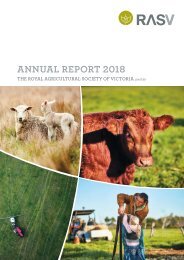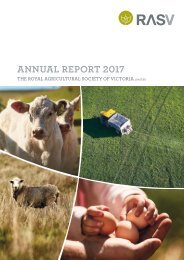2016 RASV Annual Report
The Royal Agricultural Society of Victoria (RASV) promotes and celebrates agriculture through events which connect industry with consumers and ultimately aims to improve the quality and increase demand for Victorian agricultural produce.
The Royal Agricultural Society of Victoria (RASV) promotes and celebrates agriculture through events which connect industry with consumers and ultimately aims to improve the quality and increase demand for Victorian agricultural produce.
You also want an ePaper? Increase the reach of your titles
YUMPU automatically turns print PDFs into web optimized ePapers that Google loves.
5. TRADE AND OTHER RECEIVABLES (cont.)<br />
At 31 March, the ageing analysis of trade receivables is as follows:<br />
As at 31 March <strong>2016</strong> As at 31 March 2015<br />
Trade Receivable Allowance Trade Receivable Allowance<br />
Current 226,009 249,593<br />
31 – 60 days 134,077 210,645<br />
61 – 90 days - 25,045<br />
91 days and over 7,043 (50,000) 18,299 (50,000)<br />
Closing Balance 367,129 (50,000) 503,582 (50,000)<br />
Trade receivables are initially recognised at fair value and subsequently measured at amortised cost which is the original invoice amount<br />
less an allowance for any uncollectible amount. Trade receivables are generally due for settlement within 30 days.<br />
Collectability of trade receivables is reviewed on an ongoing basis. Debts which are known to be uncollectable are written off by<br />
reducing the carrying amount directly. A provision for impairment of trade receivables is raised when there is objective evidence that the<br />
company will not be able to collect all amounts due according to the original terms of the receivables.<br />
The provision for impairment of receivables requires a degree of estimation and judgement. The level of provision is assessed by taking<br />
into account the recent sales experience, the ageing of receivables, historical collection rates and specific knowledge of the financial<br />
position of individual debtors. Significant financial difficulties of the debtor, probability that the debtor will enter bankruptcy or financial<br />
reorganisation and default or delinquency in payments (more than 60 days overdue) are considered indicators that the trade receivable<br />
may be impaired. The amount of impairment allowance is the difference between the asset’s carrying amount and the present value of<br />
estimated future cash flows. Cash flows relating to short-term receivables are not discounted if the effect of discounting is immaterial.<br />
Other receivables are recognised at amortised cost, less any provision for impairment.<br />
6. PREPAYMENTS<br />
<strong>2016</strong> 2015<br />
$ $<br />
Prepaid Insurance 222,032 232,657<br />
Prepaid Other 336,743 195,013<br />
558,775 427,670<br />
Expenses paid in the current financial year for which the economic benefits have not been completely consumed at reporting date, have<br />
been deferred and recorded as a prepayment in the Statement of Financial Position. Prepayments are amortised as an expense in the<br />
Statement of Profit or Loss and Other Comprehensive Income in future years as the economic benefits of the payment are consumed.<br />
<strong>Annual</strong> <strong>Report</strong> <strong>2016</strong> 55


















